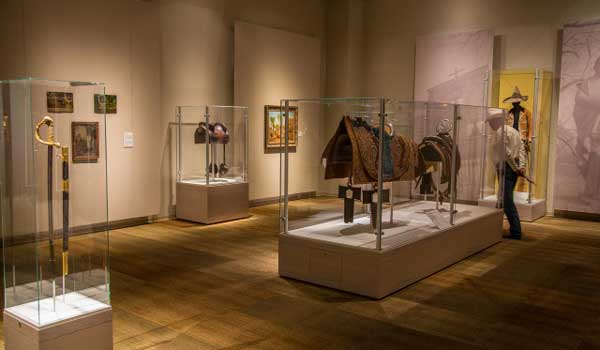The Saddle Exhibit at San Antonio’s Briscoe Western Art Museum
By Gene Fowler
If you should ever find yourself in San Antonio, Texas (and who hasn’t at some point?) and you’re an aficionado of the fine leatherwork displayed on the saddles on which vaqueros and cowboys blazed across the American West, you’ll want to see the historic saddle collection at the Briscoe Western Art Museum.
Several of the 16 saddles on display are from the collections of South Texas rancher Enrique E. Guerra and Che and Becky Guerra, owners of Nuevo Santander Gallery in McAllen. “We wanted the exhibit to show the evolution of the saddle in the West and Southwest,” says Che. One of the oldest saddles of the Guerra family collection on display is a rare 18th century silk-embroidered Spanish viceroy saddle, acquired at the annual Ethnographic Art Show in Santa Fe, New Mexico.
Primarily used for parades and other royal pageantry, the saddle features not only intricate tooled leatherwork, but also blue velvet and silk embroidery depicting flora, fauna and elaborately dressed Spanish couples. Museum curators believe the structural form utilized is probably the European estradiota saddle, which later evolved into the widely-recognized Western saddle. Experts also conjecture that the saddle would have been crafted by artisans who had traveled to the New World after receiving training in European traditions. The saddle is equipped with a horn, cantle and a rump cover. The distinctive iron cruciform stirrups, common to saddles of this period, are believed to have been used by conquistadors as a defensive weapon against natives.
A small, early Spanish estradiota saddle on loan from the Guerra Collections dates to the late 1600s to the 1750s. “This is the type of saddle they used for working cattle in northern Mexico,” Che explains. “It has no horn, but it does have the leather tapaderos that protected the rider’s legs from the brush. The vaqueros carried a lance with a half-moon shaped blade that they used to cut the Achilles tendons of wild cattle. They also used a rope that was attached to the lance. In time, they stopped using the lance and just the rope, which led to the development of the horn of the saddle, so they could tie the rope around the horn.”
One of the most elaborate saddles on display is a family heirloom, made for 85-year-old Enrique Guerra’s grandfather around 1870. Described as a haciendado saddle, it exemplifies the borderland traditions of wealthy landowners. “The horn is a silver disk,” writes Lonn Taylor, curator of the landmark 1983 exhibition, The American Cowboy, for the Library of Congress, “that is nine inches in diameter, tilted at an acute angle that gives the saddle an insouciant air, like a hat worn on the back of the head.” The iconic Mexican eagle perched on prickly pear, with a rattlesnake in its mouth, is engraved on one side of the disk, and the American bald eagle is emblazoned on the other. Ornate floral embroidery on the leather skirt and stirrups was made with a cactus fiber called pita.
Sewn behind the cantle of a circa 1840 saddle from the Guerra Collection, a thick strip of goat hair covers part of the horse’s rump. Che explains that the goatskin covers a pocket flap, conveniently concealing holsters with a pair of 1849 Colt revolvers.
Snakes and devils slither through the braided silver and tooled leather of what is believed to have been Pancho Villa’s last saddle. Crafted in the 1920s as a custom parade saddle for the storied revolutionary by Mexican leathersmith Alberto Tulan Cingo Marquez, the saddle was given to Hollywood filmmaker Howard Hawks—a collaborator on the 1934 film Viva Villa—by Villa’s widow, Maria Luz Corral de Villa. In 1957, Hawks discovered that the saddle had been stolen and then saw it offered in a 1976 auction that was advertised on television. After a six-year legal battle, the filmmaker’s estate regained custody of the saddle, and today it is on loan to the Briscoe by the Ernie and Louise Davis Collection.
Other saddles on display at the museum include a circa 1920 child’s saddle with basket stamping, a distinctive black leather and silver saddle and a 1900s military saddle, designed by General George B. McClellan in 1859 and used by the army as late as the Second World War. The McClellan saddle is on loan from the Mary Jon and J.P. Bryan Visions of the West Collection. A longtime collector, J.P. Bryan recently opened his own Bryan Museum in Galveston, where you can see a beautiful black leather and silver saddle by Edward Bohlin of Hollywood, saddle maker to the stars during the golden age of cinematic shoot-em-ups.
And as long as you’re hitting the road, the Bob Bullock Texas State History Museum in Austin exhibits one helluva unique saddle. It’s a Charro saddle with a single stirrup, believed to have belonged to Mexican presidente Santa Anna, who lost a leg in the 1840s war between the United States and Mexico.
Finally, if you’ve ever wondered what a leather shoe would look like after being submerged in seawater for 300 years, stop by the Bullock’s gallery exhibition on the shipwreck and excavation of the Belle, which came to the New World with an expedition led by the French explorer Sieur de la Salle.

